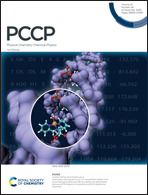Mössbauer isomer shifts and effective contact densities obtained by the exact two-component (X2C) relativistic method and its local variants†
Abstract
The analytic derivative algorithm for the effective contact densities obtained by the exact two-component (X2C) relativistic Hamiltonian is extended to the local approximations to X2C to achieve a higher computational efficiency without losing accuracy. The new algorithm has been implemented in a standalone program, which can utilize the molecular orbitals from state-of-the-art ab initio or density functional theory (DFT) calculations by other quantum chemistry programs in connection with various relativistic Hamiltonians. With the help of the utility program, the effective contact densities as well as the related Mössbauer isomer shifts can be studied by various advanced single-reference and multi-reference ab initio methods as long as the canonical or natural orbitals are available. Using the developed algorithm, the effective contact densities and the Mössbauer isomer shifts in a series of iron compounds and in HgFn (n = 1, 2, 4, and 6) molecules were studied. The obtained results show that (1) adequate account of the static electron correlation significantly improves the agreement of the theoretical 57Fe effective contact densities with the experimental isomer shifts, and (2) the non-monotonous changes of the effective contact density in a series of HgFn compounds are caused by the increasing screening effect due to shrinking of the Hg 5d orbitals.

- This article is part of the themed collection: 2020 PCCP HOT Articles


 Please wait while we load your content...
Please wait while we load your content...